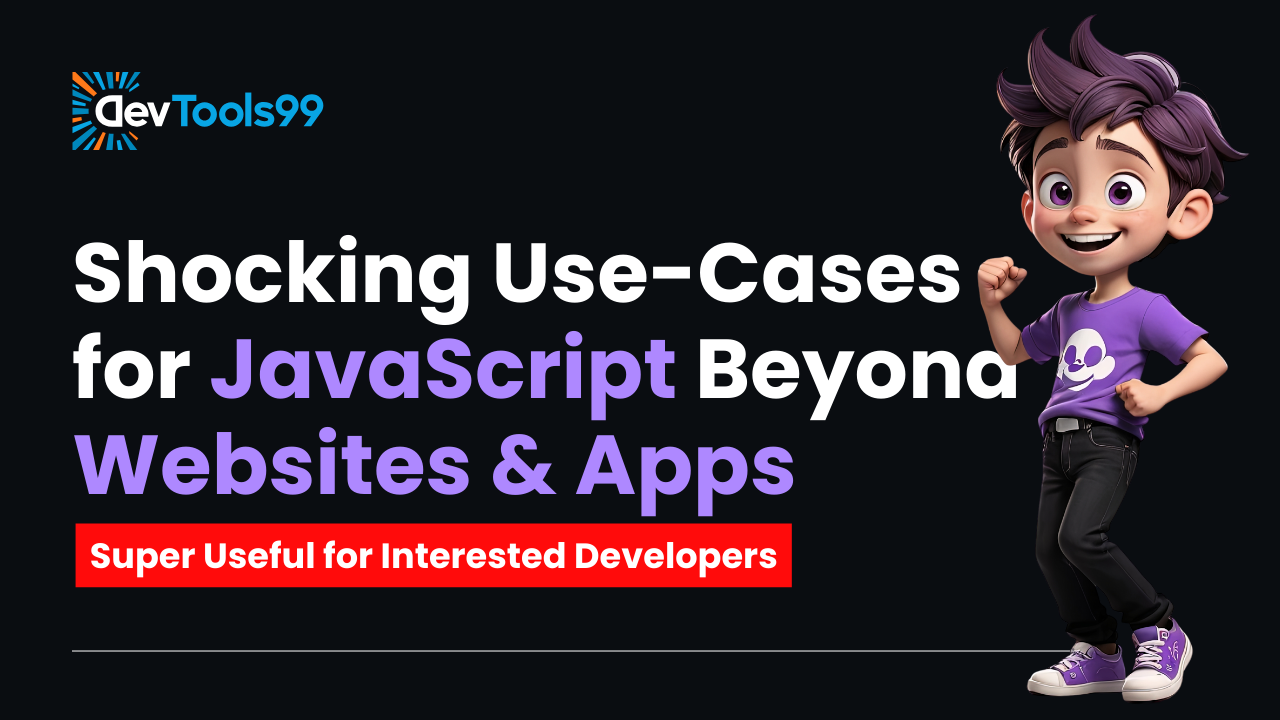
Shocking Use-Cases for JavaScript Beyond Websites & Apps
JavaScript is widely recognized for its capabilities in building dynamic websites and applications. However, its versatility stretches far beyond the digital confines of browsers and mobile apps. From automating home devices to creating music and even controlling robots, JavaScript's applications are profoundly reshaping our interaction with technology. In this blog, we'll dive into some of the most unexpected and exciting areas where JavaScript is making a significant impact.
1. JavaScript in Robotics: Control Robots with Johnny-Five
One of the most thrilling developments in JavaScript is its application in robotics. Utilizing frameworks like Johnny-Five, developers can control physical objects in the real world. Johnny-Five communicates with microcontrollers like Arduino to operate devices such as drones and automated systems. For instance, you can create an automated plant watering system that keeps your greenery hydrated or program drones to perform precise movements, like flying through an obstacle course or capturing aerial footage.
The power of Johnny-Five lies in its accessibility. You don’t need a background in embedded systems to get started. With JavaScript, you can easily control motors, sensors, and actuators, opening a world of possibilities for both hobbyists and professionals interested in robotics.
// Example code to make an LED blink with Johnny-Five:
const five = require("johnny-five");
const board = new five.Board();
board.on("ready", () => {
const led = new five.Led(13);
led.blink(500); // LED will blink every 500ms
});
2. JavaScript in Your Home: Control Smart Home Devices
Ever dreamed of controlling your home with just a few lines of code? JavaScript has entered the world of smart home technology, enabling automation and control of devices like lights, thermostats, and more through platforms like Node.js and various APIs. You can sync JavaScript with smart home systems such as Philips Hue lights, Nest thermostats, or even entire home automation hubs.
With this, JavaScript transforms your home into a programmable environment. For example, you could write a simple program that dims your lights automatically at sunset or turns on the heating when the temperature drops below a certain point. Whether for convenience, energy savings, or pure curiosity, JavaScript allows you to automate and control your home in ways previously unimaginable.
// Example code to control a smart light with Node.js and the Philips Hue API:
const hue = require("node-hue-api");
const LightState = hue.v3.lightStates.LightState;
const api = await hue.v3.api.createLocal("your-bridge-ip").connect("your-username");
const state = new LightState().on().brightness(100);
await api.lights.setLightState(1, state); // Turns on the light with full brightness
3. JavaScript Makes Music: Create Sound Effects with Tone.js
Did you know JavaScript can help you create music? With libraries like Tone.js, developers and musicians alike can generate music, design sound effects, and build audio applications. Whether you're creating beats, composing entire soundtracks, or exploring musical scales, JavaScript can be your creative playground.
Tone.js provides high-level functions that abstract complex audio processes, making it easier to compose, sequence, and manipulate sound directly in the browser. Imagine combining code and creativity to generate random melodies or synchronize music with animations on a webpage. The boundaries of web development and music production are blurring, and Tone.js is at the forefront of this change.
// Example of playing a simple melody with Tone.js:
const synth = new Tone.Synth().toDestination();
const notes = ["C4", "D4", "E4", "F4", "G4", "A4", "B4", "C5"];
Tone.Transport.scheduleRepeat((time) => {
let note = notes[Math.floor(Math.random() * notes.length)];
synth.triggerAttackRelease(note, "8n", time);
}, "4n");
Tone.Transport.start();
4. JavaScript in VR: Build VR Experiences with A-Frame
JavaScript is also pushing boundaries in virtual reality. Using the A-Frame framework, developers can create immersive VR experiences directly in the browser without the need for specialized hardware or advanced programming knowledge. With A-Frame, you can build everything from simple 3D objects to complex interactive virtual environments that can be explored using VR headsets or even standard web browsers.
From virtual tours to interactive games, A-Frame offers endless possibilities for developers and creators looking to explore the world of virtual reality. And since it’s all JavaScript, you can integrate VR directly into websites, providing users with seamless, engaging experiences without leaving their browser.
// Example of creating a basic VR scene with A-Frame:
<a-scene>
<a-box position="0 1.5 -3" rotation="0 45 0" color="#4CC3D9"></a-box>
<a-sky color="#ECECEC"></a-sky>
</a-scene>
5. JavaScript in Data Science: Visualize Data with D3.js
JavaScript has also made its mark in the field of data visualization. Libraries like D3.js (Data-Driven Documents) allow developers to transform raw data into beautiful, interactive visualizations such as graphs, charts, and maps. By manipulating the Document Object Model (DOM) based on data input, D3.js creates powerful, customized visuals that help users understand and interpret complex datasets.
From business dashboards to scientific research, D3.js brings data to life, making it easier to spot trends, patterns, and insights. Whether you're dealing with financial reports or climate data, D3.js ensures that your audience not only sees the numbers but also grasps their significance.
// Example of creating a simple bar chart with D3.js:
const data = [30, 86, 168, 281, 303, 365];
d3.select(".chart")
.selectAll("div")
.data(data)
.enter().append("div")
.style("width", (d) => d + "px")
.text((d) => d);
Conclusion
As we've explored, JavaScript is no longer confined to building websites and apps. From robotics to music, smart homes to virtual reality, and data visualization, JavaScript is expanding its influence in surprising and innovative ways. It’s powering the future of technology, making things we once thought impossible, possible.
The next time you write a line of JavaScript, remember that you're part of a rapidly growing ecosystem that extends far beyond the browser—it's literally shaping the future of technology!
Follow Us:
Stay updated with our latest tips and tutorials by subscribing to our YouTube Channel.
